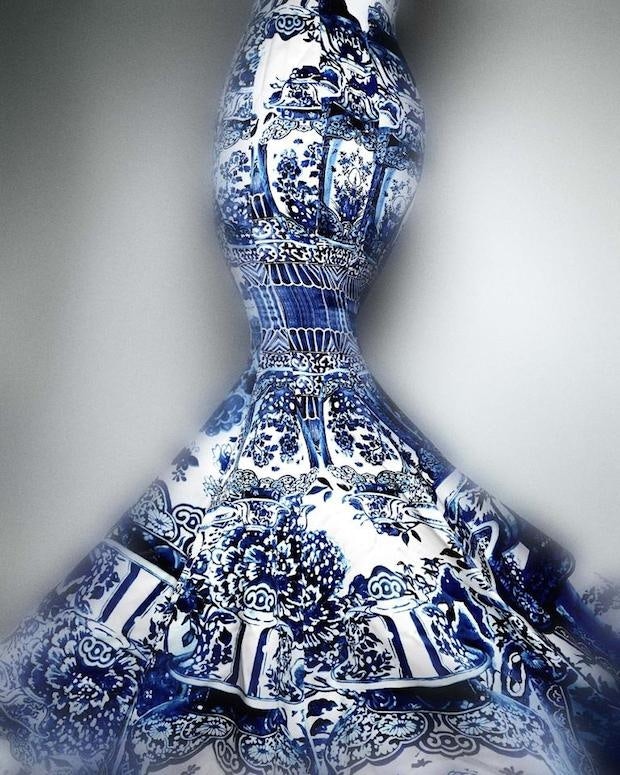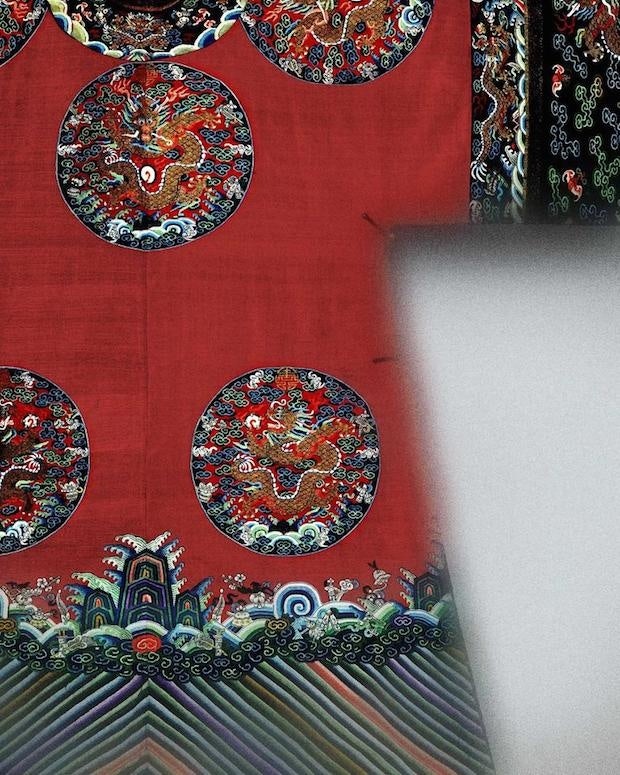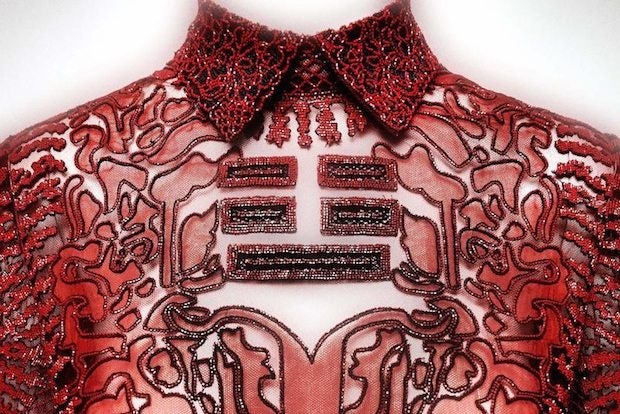
A China-exclusive dress created by Valentino and presented in Shanghai in 2013 that will be on display at the Metropolitan Museum of Art Costume Institute's "China: Through the Looking Glass" Exhibit. (Metropolitan Museum of Art)
An opulent purple Jean-Paul Gaultier silk-satin sheath that references the stereotype of “Asian women having mysterious powers of sexual mastery.” An Yves Saint Laurent gown that represents “the cinematic stereotype of the dragon lady in a tight sheath.” A Chanel version of a qipao (i.e. “cheongsam”) inspired by the 1960 British-American film The World of Suzie Wong.
According to the Metropolitan Museum of Art’s new Costume Institute exhibit, “China: Through the Looking Glass,” these stereotype-driven creations represent the ways that an overwhelming number of the world’s top designers have long envisioned “Chinese fashion”—designs centered around fictional China fantasies that were created almost solely for Western consumption.
Although many of the over 140 examples of this trend on display at the upcoming exhibition were created surprisingly recently—some within the past decade—they now more than ever represent a bygone era in the global fashion industry. That might be due less to a political correctness wave, however, and more to economics. Now that Chinese shoppers are the top customer base for most of the brands on display at the exhibit, designers must focus on creating clothes for China, not just about China.
The new exhibit that kicks off with the glamorous annual Costume Institute Benefit (or “Met Gala”) on May 4 may have “China” in the name, but it’s “not about China per se,” said curator Andrew Bolton in a recent Women’s Wear Daily article. Rather, it’s mainly about the way Western designers interpret Chinese culture, or “a China that exists as a collective fantasy.” As the Met points out in its description of the event, much of this fantasy was driven by classic films set in 1920s, 30s, and 40s China—and these often had highly problematic themes. For example, Suzie Wong is commonly criticized for racism and sexism, while films starring famous Chinese-American actress Anna May Wong often portrayed her as either a “painted doll” or a “scheming dragon lady.”

An evening gown by Roberto Cavalli based on Chinese porcelain that will be on display at the Costume Institute's new exhibit, "China: Through the Looking Glass." (Metropolitan Museum of Art)
While many of the dresses being displayed don’t go full-on “dragon lady” and often just take inspiration from films actually by Chinese directors or from Chinese artwork, most of the ones revealed so far do represent the sartorial equivalent of Orientalism, a term which historically referred to the study of a broad swath of territory referred to as the “Orient,” including Asia and the Middle East. When professor Edward Said published his groundbreaking book Orientalism in 1978, he pointed out the problematic side of works of art or literature deemed “Orientalist,” noting that they often relied on patronizing racial stereotypes of “exotic” or “mystical” “Eastern” cultures that often portrayed them as static and backward. According to Said, Orientalism was out of touch with on-the-ground realities in Asian and Middle Eastern countries, despite being part and parcel of Europe’s colonial enterprises in those places. In a recent interview with Vogue, Bolton agreed that many of the dresses on display at the exhibition fit the rubric of Orientalism, but he argues this isn’t a negative when it comes to fashion because it represents “an exchange of ideas and an honored source of influence."
For the fashion designers with pieces on display, it will ultimately be wealthy Chinese consumers who make the final judgment call on this issue—with their wallets. Even if certain designs with Chinese elements don’t come across as offensive, they won’t resonate with consumers if they show a lack of understanding of Chinese culture. China can no longer exist just in fashion labels’ fantasies if they want to stay in business, and the perception that a garment is culturally tone-deaf will now lead directly to decreased profits. Over the past decade, Chinese luxury spending has grown tenfold and represented 30 percent of the global luxury market in 2014, according to Altagamma and Bain. This has been a rapid and groundbreaking change, since they accounted for only 3 percent only 10 years earlier (a time when many of the dresses at the exhibit were created). That number is just the average, and is much higher for some fashion brands—Chinese consumers make up 38 percent of Prada’s customer base, 37 percent of Gucci’s, and 35 percent of Bottega Veneta’s and Burberry’s, according to estimates from Exane BNP Paribas.
Designers have already become acutely aware of this shift, and the exhibit itself makes this clear. For example, it features a 2013 dress created by Valentino as part of an 85-piece capsule collection exclusively for the China market, which was presented in a special Shanghai runway show. Rather than featuring outfits that looked like they belong on the set of a culturally insensitive 1960’s movie about 1920’s-era Shanghai, the collection gave a nod to Chinese aesthetics with a red color palette while presenting pieces that were realistically wearable by the average urban Chinese fashionista.
In a recent interview with Bolton published in Vogue, designer John Galliano noted that he has made this shift consciously since he began including Chinese motifs in his designs decade ago. “I was fascinated with the culture. In retrospect, I think it was because I knew very little about it. Before I visited China, it was the fantasy that drew me to it, the sense of danger and mystery conveyed through Hollywood,” he said, noting that “much later, I learned more about the real China through research—paintings, literature, architecture. My design process involves in-depth research, and I make a scrapbook for every collection with images that show my current thinking. But, yes, my initial interest in China was fueled by movies, by their fantasized and romanticized portrayals.”

A woman's imperial court robe from China that will be exhibited at "China: Through the Looking Glass." (Metropolitan Museum of Art)
Exhibit organizers have also been cognizant of the importance of their Chinese audience. Director Wong Kar-wai is the exhibition’s artistic director, while actress Gong Li serves as one of the co-chairs of the Met Gala. To promote the exhibit in China, Vogue Editor-in-Chief Anna Wintour traveled to Beijing in January, unveiling new details and securing a loan for exhibit of a robe worn by Pu Yi, China’s last emperor. The exhibit will be featuring film clips by Wong as well as Chinese directors Zhang Yimou, Chen Kaige, and Ang Lee, and will also be showing a few pieces by Chinese designers including Guo Pei, Laurence Xu, and Vivienne Tam. The Costume Institute is also teaming up with the museum’s Department of Asian Art in order to juxtapose the designers’ creations with the original Chinese garments, paintings, porcelains, and art that inspired them.
The mass public perception of the exhibition will be shaped in large part by the images that emerge from the Met Gala itself, which has designated a “Chinese white tie” dress code and is causing speculation that confused celebrities may show up in culturally insensitive attire. If celebrities and the designers they're wearing receive criticism, it will affect their standing not only in the United States, but in the China market as well.
Visitors to the exhibition who want to see the what the new face of Chinese fashion looks like need to only travel a few blocks away to Barney’s, which is selling a special-edition capsule collection by China-born, London-based designer Huishan Zhang to celebrate the exhibit. The award-winning Zhang is part of a crop of emerging young Chinese designers such as Masha Ma, Yang Li, and Yiqing Yin, who are enjoying growing impact by appearing at the world’s top fashion weeks and being sold in major department stores worldwide. The next time the Met’s annual fashion exhibit is China-themed, Chinese names rather than Western ones will likely be the ones taking center stage.
